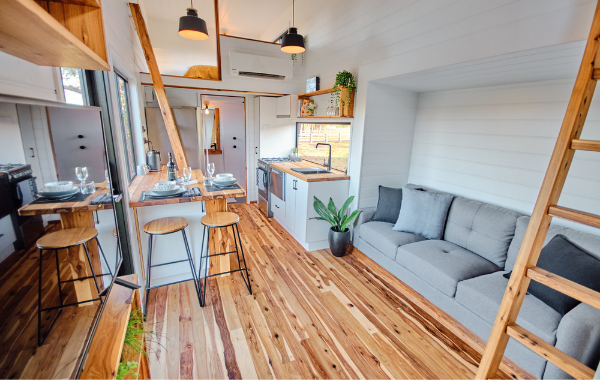Why Australians are going crazy for tiny houses

Jakara Anthony celebrates winning the overall World Cup title in 2023-24 for moguls freestyle skiing at Deer Valley, USA. Photo: FIS FREESTYLE/MATEUSZ KIELPINSKI
THE demand for tiny houses surged around the world with the COVID-19 pandemic. Australia is no exception.
Underpinning this growth trend for tiny houses is housing affordability, the lure of an untethered lifestyle, financial freedom and the appeal of a minimalist lifestyle. And the many disruptions to employment, changes in working patterns, working from home, travel and other restrictions also fueled the demand for tiny houses everywhere. Australia is no exception.
Top trends driving the demand for tiny houses
Here are the top trends that are driving the demand for tiny houses all across Australia.
1. Crazy high housing costs across Australia
This is no surprise. Our housing costs are very high, and rising across Australia despite the abundance of land and a pretty low population density of 3 persons per each square kilometre.
And it is not just the housing prices that have been rising. The costs of living are rising too, driven by pandemic related supply chain disruptions, raw material costs and the rising oil prices globally. The trend is unlikely to reverse since the war between Russia and Ukraine is likely to keep oil prices high for many months ahead. The Reserve Bank of Australia expects things to get worse on inflation before it gets better. Pretty soon, you will see rising interest rates, and escalating home loan interest rates, making the housing burden even more difficult to bear. This is but one one reason driving the popular demand for tiny houses in Australia.
Changing lifestyle preferences are also at the root of what drives the demand for tiny houses.
2. Sustainable living options
Everything we use—from toothbrush and toothpaste to the paper towel and iPhone—has an environmental cost in terms of carbon emissions. In other words, things have carbon embedded in them. If you want to be environmentally friendly and reduce your personal carbon footprint, a tiny home is a great way to get there. Tiny home owners seeking sustainable living options use very few resources, minimal water and electricity. Most tiny houses can be fitted with compostable toilets. They also come with grey water recycling options. They can be fitted to be completely off-grid with solar panels.
3. The lure of flexibility
As they say, unexercised options are more valuable than exercised options, both in investing and in life. Tiny houses are epitomes of flexibility. And they open up so many possibilities and lifestyle options. People today, compared to previous generations, value that flexibility. They are willing to try new types of housing arrangements to suit their varying needs. Need a granny flat? Want to earn some extra income with Airbnb? Your current home is getting cluttered, but an extension will simply be a costly hassle? Want a studio for creative work? An isolated man-cave, a meditation retreat, office or writing space separate from the family home? People are considering tiny houses as a truly viable option for many of these use cases.
4. The growing trend of downsizing
Downsizing – quite common now in the Western world – is also being embraced by Australians in large numbers. The trend began with baby Boomers downsizing the empty nests. But now, younger cohorts, such as Gen X and the Millennials are joining them, for their own special reasons. They seek to simplify their lives, placing less emphasis on material things and aiming to reduce stress and complications of material consumption. They appreciate that ownership – of anything, including a big home – eats into time that could be better spent in more enjoyable ways. A tiny house solves this problem.
5. Pursuit of financial freedom
The dream of owning one’s home does not come stress free. High housing costs and home loan interest rates mean that you must forgo a big chunk of earnings as the price of that dream. Their affordability – you don’t have to keep paying a mortgage for 30 years – makes tiny houses appealing to people seeking financial freedom. They want their home, but without the exorbitant opportunity cost and the attendant high stress lifestyle that lasts a lifetime.
The FIRE movement – of those seeking to be Financially Independent Retire Early – also feeds the demand for tiny housing.

6. Embracing leisure, fitness and outdoors
“What is this life if, full of care, we have no time to stand and stare?” asks William Henry Davies. Increasingly more Australians are beginning to venture outdoors. They see the futility of spending a big part of their leisure cleaning a big house. True they make perfect holiday homes, but to many, tiny homes on wheels offer a refuge, an opportunity to get away, a ticket to freedom and an untethered lifestyle. It gives them the opportunity to “stand beneath the boughs…and stare as long as sheep or cows” if they want to!
7. Versatility appeals to people and businesses alike
The Australian tiny house industry is now offering a variety of models for one, two, three or more people to live in. This appeals to a wide range of people including downsizers, empty nesters, and those wishing to become Airbnb renters.
Many farm owners and other businesses have begun using tiny houses as accommodation for seasonal workers. Some offer tiny houses for out of town employees until they find their own accommodation or even longer term.
8. Ease of getting approvals or not needing approvals
Technically, tiny houses are classed as caravans in almost all council and land regulations around Australia. You don’t need council approval to park a caravan on wheels on your property. Think of this as a bonus. It is a perfectly legal “loophole” that makes it straightforward to own a tiny house and place it on your residential or rural land. You may need approvals under some circumstances including moving them from one location to another.
9. Tiny houses are road legal
Tiny homes only require road registration when it’s on the road – typically for delivery only. They are built to be legally transportable on Australian roads, and are blue slipped with a Vehicle Identification Number (VIN) that make them road registerable, where necessary. You’ll need an affordable temporary permit from the RMS if you plan to move it by road.
10. Functionality and optimum comfort
Just like big does not mean luxury, tiny does not mean spartan or lacking in comfort. Tiny houses are cleverly designed to offer you a pleasant living experience with a high level of functionality and comfort. Well designed tiny houses have all the familiar trappings that make a house a home. They are simply optimised for a compact living experience.
11. Tiny houses are affordable
Affordability is undoubtedly one of the biggest factors that drive the demand for tiny houses across Australia, and across the world. The typical costs of high-end tiny houses from the likes of Hauslein falls in the range between $93,500 to $130,000 for base prices. Yes, amazingly, that is about five to ten times less than most regular house and land packages you will find in the major metro centres of Australia.
With all of these trends and the advantages in comparison with regular homes, is it a wonder that more people are turning to tiny houses, driving the demand for them through the ceiling?
“Although the build time for a tiny house is between 8 to 12 weeks depending on the model, as a leading tiny house builder we have a waiting list to work through,” says David Boyd, a co-founder of Hauslein.

















